108 Gamification Elements and Mechanics to Encourage Engagement
Which gamification elements to use for your future gamification project?
In this epic post, we will take you through the 108 Gamification elements and mechanics you might need for your future gamification strategy.
When you decide to grow your company, it’s important to think about employee commitment.
How do you maintain excitement and engagement within your business?
Your team needs collaboration and motivation in order to thrive. Be it internal or external, you must know that it won’t happen out of the blue.
It takes time, and most importantly a system. A system that can happen step by step while being monitored and guided.
That’s where gamification comes in.
However, gamifying a system is not the easiest thing.
First, it’s important to know all the rules and dynamics, making sure teamwork increases and everyone sees results getting better.
Second, you need a way to measure improvement, otherwise, you can’t see the changes actually taking place.
The good news is that gamification offers specific tools to use for different human motivations. That means that, by using the right methods, you can achieve the results you’re looking for without reinventing the wheel.
It’s a process, and that’s good because no one wants to mess with a team that is working well if it’s not going to improve anything.
To guide you through this process, we prepared a definitive list of all gamification mechanics and elements to quickly start gamifying your team. We unveiled the most relevant gamification elements and mechanics out there so you can start right away. Let’s do this?
In this article, you will learn: Table of Contents
Here’s the complete list of gamification examples.
Download your free
“108 Gamification Elements and Mechanics”
Get your cheat sheet and have a quick reference at your fingertips!
What are Gamification Mechanics?
Simply put, gamification mechanics are the rules which define how the game is going to work. Think of it as the rule book you see in board games. According to Kevin Werbach and Dan Hunter, gamification mechanics are challenges, chance, competition, cooperation, feedback, resource acquisition, rewards, transactions, turns, and win states.
What are Gamification Elements?
What are Gamification Elements?
Gamification elements refer to the set of strategies taken from games that are used in real-life situations like call centers, loyalty programs or community engagement. You might’ve heard – and applied – some of them over the course of your life. Leaderboards, levels, points, quests, sharing, boosters, boss fights, magnetic cap, and so on. Does it ring any bells?
What are Player Types?
Every person is unique – and so are their preferences. Whenever you decide to play a game, the same thing applies: every player has preferred actions and objectives.
Some people are highly competitive and will do anything for points, coins, and status. Some others are more keen on collaboration and fond of making new friends, having pretty relaxed playing manners. For the latter, they are usually aware that helping friends to achieve their goals will also benefit them.
Richard A. Bartle, professor and game researcher, classified some common player characteristics into 4 different player types:
- Socializers
- Explorers
- Killers
- Achievers
Although a person can carry traits from all of them, there’s always a tendency for one to be the winning character. So, more than knowing your set of gamification mechanics, it’s fundamental to know what motivates people in your team. What are their core drives?
By knowing what drives them, it’s easier to implement the correct gamification dynamic (or emotions) to your game while achieving the desired behaviour.
What are Motivational Core Drives?
Everything that is engaging and motivates you to perform a behaviour is a motivational core drive. According to Yu-kai Chou, there are 8 core drives that motivate people to act:
- #1 Epic Meaning and Calling
- #2 Development and Accomplishment
- #3 Empowerment of Creativity and Feedback
- #4 Ownership and Possession
- #5 Social Influence and Relatedness
- #6 Scarcity and Impatience
- #7 Unpredictability and Curiosity
- #8 Loss and Avoidance
Motivational Core Drives: Black Hat x White Hat
Human motivation comes from all sources of things. When implementing your elements, you can either choose to go with “white hat” or “black hat” to drive motivation.
But what are the black hat and white hat core drives of motivation?
Fundamentally, black hat core drives happen when players face a loss of control. So that, feelings like obsession, urgency, and addictiveness are experienced
Black hat core drives can be seen in:
- Scarcity & Impatience
- Unpredictability & Curiosity
- Loss & Avoidance
- Ownership and Possession
- Social Influence and Relatedness
On the other hand, white hat core drives create a sense of control and empowerment. This way, players are content and pleased, feeling strong and fulfilled.
White hat core drives can be seen in:
- Epic Meaning & Calling
- Development & Accomplishment
- Empowerment of Creativity & Feedback
- Ownership and Possession
- Social Influence and Relatedness
Did you notice anything odd? The two core drives called “Ownership and Possession” and “Social Influence and Relatedness” are in both lists. That happens because they have the duality of being either white hat or black hat.
Ownership and Possession can refer to owning things that make us feel like we are in control (white hat), but at a certain point, we might have the feeling that those things are owning us (black hat).
Social Influence and Relatedness, on the other hand, refers to when we’re building relationships and expressing esteem for each other (white hat), but at the same time, peer pressure can cause us pretty traumatic experiences in life (black hat).
Despite black hat techniques carrying bad fame, when used in small doses they are crucial to bringing some excitement and urgency into the game. If there’s a lack of black hat core drives, chances are that players will get bored soon, stop playing and leave the game. No one wants that, right?
Download your free
“Gamification Guide”
Get your PDF now and start transforming your approach to digital engagement!
Gamification Elements and Mechanics
1. Points / Points System
Points can be used as the unit of measurement that quantifies a user’s progression and improvement throughout the game. Points can also be used to unlock things. What is unique about this feedback mechanic is that you can use different points in the same strategy or scenario:
- Absolute status points or experience points: to measure the total amount of progression.
- Marginal status points: to measure the amount of progression for a period of time, as in competitions or challenges. These points can be reset when the challenge is over.
- One-way status points: points that can only go up. Never down.
- Two-way status points: points that can go down in case the user fails to complete a task, performs a negative action or simply doesn’t interact with the system for long periods of time.
Points can also be subdivided according to their functionality, such as:
- Experience Points (XP) / skill points
- Status Points
- Redeemable Points
- Karma Points
- Gift Points
- Reputation Points
- Expiring Points

Who talked about it:
Andrzej Marczewski, Yu-kai Chou, Gabe Zichermann, Christopher Cunningham, Kevin Werbach, Dan Hunter, Janaki Mythily Kumar and Mario Herger
2. Progress / Feedback
Progress and feedback are measurements used to let users know where they stand in relation to hitting their goals. All user types require some kind of measure of progress or feedback to understand where they are in the game and what they can expect.
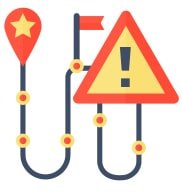
Progress/Feedback example:
Progress bars, points, notifications are some of the many tactics.
Who talked about it:
Andrzej Marczewski, Janaki Mythily Kumar and Mario Herger
3. Leaderboards / Ladders / Ranking
Simply put, a leaderboard is a board that displays the names, points and positions of individuals or teams in a competition. Through leaderboards, users can visualize their own achievements and know exactly where they stand relative to the competition.
Leaderboards can be designed as a black hat or white hat technique. It can bring either satisfaction or frustration. This means you really need to understand your audience to make sure leaderboards are the right tool for the occasion.
Leaderboards can be organized:
- Geographically – set leaderboards to show how other users from different locations or the same location are ranking
- Socially – set leaderboards to show how social media friends stand in the game
- By experience level – set leaderboards to show only players with similar levels of performance
- Contextually – set leaderboards to show players by category or area in the company
- By the period of time – set leaderboards to show the best players of the week, month, or quarter
Leaderboards don’t necessarily have to be used to compare people, you could use them to, for example, compare content that people interact with, or popular posts based on upvotes. You can really get creative with what you compare and you could end up generating more motivation than comparing individuals themselves

Who talked about it:
Andrzej Marczewski, Yu-kai Chou, Janaki Mythily Kumar, Mario Herger, Gabe Zichermann, Christopher Cunningham, Kevin Werbach & Dan Hunter
4. Guilds / Teams
Some gamification designers call it teams, others call it guilds. Some call it clans and others call it communities or even alliances. Whichever you choose, they are all just different names for the same thing: people who play together as a group to achieve common goals and objectives. People will form teams based on a variety of factors, whether it’s similar or complementary playing styles, interests, or even levels of engagement with a game.
It doesn’t matter the size of the team, it’s always a great way to introduce social features into your game (like sharing or recognising).

Guilds / Teams example:
Massively multiplayer online games are in vogue these days where people get together to achieve common goals (like defeating an opposing team).
Who talked about it:
Andrzej Marczewski, Kevin Werbach and Dan Hunter
Download your free
“108 Gamification Elements and Mechanics”
Get your cheat sheet and have a quick reference at your fingertips!
5. Physical Rewards / Prizes
Physical rewards, prizes, tangible rewards, or extrinsic rewards are all different names for the same thing. They are, by definition, benefits that come from an external source like an employer, manager, website or an app. After getting those rewards, users, learners or employees can touch, spend or use their prizes.
Physical rewards are commonly used for behaviour conditioning and user motivation. It can work well for short-term motivation. However, they aren’t necessarily the most sustainable in the long run, nor are they necessarily the most effective (see the SAPS concept). There are various ways a company can use external rewards to benefit its employees.

Physical Rewards / Prizes example:
Salary increase, paid vacations, bonuses, club memberships, service upgrades, mobile phone and so on.
Who talked about it:
Andrzej Marczewski, Yu-kai Chou, Kevin Werbach, Dan Hunter, Janaki Mythily Kumar and Mario Herger
6. Badges / Achievements
In gamification, badges and achievements are virtual symbols used as a form of reward to signal the accomplishments of users. Badges are the visual display of the user’s capability to do something or acquire a new skill. The benefits of using badges and achievements are:
- Promotes guidance and feedback
- Create higher performance expectations
- Increase user self-efficacy
- Satisfaction for completing a task
- Creation of goal commitment
- Support social proof
- Stimulate social comparison
- Engage users to continue the tasks by keeping them in the flow state
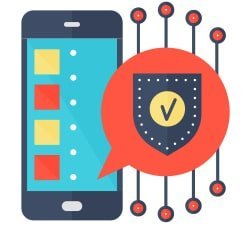
Badges / Achievements example:
Skill mastery, task proficiency, extracurricular e-learning activities and so on.
Who talked about it:
Andrzej Marczewski, Yu-kai Chou, Janaki Mythily Kumar, Mario Herger, Gabe Zichermann, Christopher Cunningham, Kevin Werbach and Dan Hunter
7. Random Rewards
Random rewards are a great way to keep users engaged with a game. Also known as a mystery box, which as the name already suggests, adds a bit of mystery and surprise which people love.
Essentially, a reward is given for completing a required action. However what makes it interesting, is that users don’t know what the reward will be. This is quite exciting because the unknown reward might be extremely valuable and help users to advance further in the game.
For some users, the element of surprise is a reward in and of itself.

Random Rewards example:
Mystery box or loot boxes.
Who talked about it:
Andrzej Marczewski and Yu-kai Chou
8. Social Discovery
Allowing people to find you or having ways for you to connect with others is a great way to create new relationships. It feels good to meet new people and form new relationships even in games. Use different criteria to match people, maybe by location, interest or level of engagement.

Social Discovery example:
Determining the interests of your players and showing them others who share their same interests.
Who talked about it:
Andrzej Marczewski
9. Time-Dependent Rewards
This type of reward is only given at specific moments in time, like a birthday, a special date or during a specific period of time. Time dependent rewards can also be based on set periods of time e.g. available once a day or once week.
Do you know those games which give you points the first time you login during any particular day? Well, that’s a simple type of time-dependent reward!

Time-Dependent Rewards example:
Birthday coupons or daily gifts.
Who talked about it:
Andrzej Marczewski
10. Social Network / Friending / Relationship
Why not connect with friends using a social network feature? It can be more fun to play with others rather than to play alone! Connecting with social networks can be used to influence the experience with new content, feedback and more in game activities. This can increase others awareness of a player’s activities and boost the appeal of the game to users who are not currently playing.
Social networks can also promote a collaborative environment, improving the quality of the game for all participants. Another interesting way to keep users motivated is to offer great rewards for referring their friends to the game, or offering challenges which are exclusively team based.

Social Network / Friending / Relationship example:
Team based multiplayer games or rewards for inviting friends to play with you.
Who talked about it:
Andrzej Marczewski, Yu-kai Chou, Janaki Mythily Kumar and Mario Herger
11. Progress Bar
Progress bars are an incredibly simple yet extremely effective technique to nudge users towards taking action. Progress bars visually indicate how far along you’ve come and how much you have left to go. It’s easy to feel the need to complete a task to see that progress bar, that was teasing you at 75%, reach the 100% mark.
A progress bar is usually a graphical element that illustrates the percentage of a task (or set of tasks) that has been completed by gradually filling its empty space with solid segments.

Progress Bar example:
The almighty LinkedIn profile progress bar that moves towards completion the more you populate your profile. This can also be applied to many corporate processes that involve several steps to complete or in training scenarios that are broken down into stages.
Who talked about it:
Andrzej Marczewski, Yu-kai Chou, Gabe Zichermann and Christopher Cunningham
12. On-boarding / Step-by-Step Tutorials
On-boarding or tutorials are interactive messages, usually presented in video format and used for:
- Greetings – to give a nice, warm or funny welcome, creating an emotional bond with users.
- Incentivizing – to praise efforts and achievements. This is the best way to recognize and motivate users to complete a task and go the extra mile to the next challenge.
- Learning – to provide step-by-step instructions explaining how everything works.

On-Boarding/Tutorials example:
How-to videos and step-by-step guides with a collection of examples.
Who talked about it:
Andrzej Marczewsk, Yu-kai Chou, Gabe Zichermann and Christopher Cunningham
13. Social Pressure & Relatedness
Social pressure is an important core drive which can influence the way we behave based on the behaviours’ of others. Some people are influenced by other individuals and some people are influenced by groups of their peers. No one is a fan of feeling excluded and most people have a need to be accepted.
Relatedness influences people’s behaviour in the sense that people look for products or services that are familiar to them. This might be due to a lost memory of their childhood or place of birth, for example. It’s not uncommon to see people choosing one product over another just because they have an emotional connection to it.

Social Pressure & Relatedness example:
Group quests, friendliness, social treasure, gifting, seesaw bumps, tout flags, brag button, water cooler, conformity anchors or mentorship.
Who talked about it:
Andrzej Marczewski and Yu-kai Chou
14. Social Status
Social status doesn’t only exist in real life, it also can exist in games. No matter if it’s for being the best performer, contributor or sharer, those at the top have more status than those that are at the bottom.
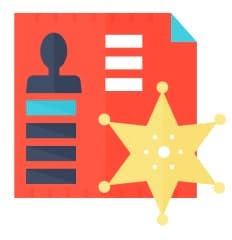
Social Status example:
Status can be associated with leaderboards, badges, certificates, and levels.
Who talked about it:
Andrzej Marczewski
15. Experience Points (XP) / Skill Points
Experience Points (XP) or skill points are feedback mechanics associated with completion of desired behaviours or achievements. Experience points can be used to track progress or as an exchange mechanism for acquiring stuff. Generally speaking, the longer a user plays or interacts with a system the more experience points they will earn.

Experience Points (XP) / Skill Points example:
Many modern e-learning systems come with a concept of points which can be earned for completing training. In games, experience points are prevalent and available in most major gaming franchises in some shape or form.
Who talked about it:
Andrzej Marczewski, Yu-kai Chou, Gabe Zichermann and Christopher Cunningham
16. Competition / Duel / Combat
Gamification is a great opportunity to encourage people to develop real-life skills and discover the best in themselves. After all, those who want to be amongst the winners need to work hardest to have the best performance!
Competitions, duels or combats can be set between individuals or teams. When making one team compete against the other, you can improve motivation and productivity while encouraging team members to cooperate and work together effectively.
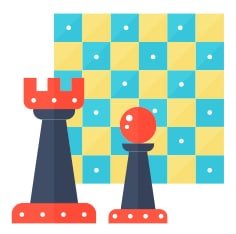
Competition / Duel / Combat example:
Most of our sports are considered competitive by nature, whether that’s individuals or teams competing to win a medal or a trophy.
Who talked about it:
Andrzej Marczewski, Kevin Werbach and Dan Hunter
17. Fixed Action Reward or Earned Lunch
Fixed action rewards or the “earned lunch” technique is the easiest and most predictable type of the reward. Users know exactly what they need to do and what they will earn as a result of performing the specified action.

Fixed Action Reward or Earned Lunch example:
Loyalty programs that involve collecting points such as frequent flyer miles or hotel reward programs.
Who talked about it:
Andrzej Marczewski and Yu-kai Chou
18. Variable-Ratio Schedule Reward
This was one of the reward schedules that was studied by B.F. Skinner. The idea is that the player is not rewarded for each time they perform a behaviour or sequence of behaviours. Instead, the number of times the user needs to perform the behaviour or sequence will vary, rewarding the user with an unpredictable pattern.
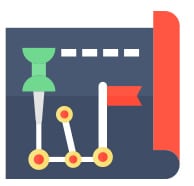
Variable-Ratio Schedule Reward example:
Slot machines are a classic example where the behaviour doesn’t change but the reward schedule varies.
Who talked about it:
Andrzej Marczewski, Kevin Werbach, Dan Hunter, Janaki Mythily Kumar and Mario Herger
19. Challenges
Challenges are powerful tools to motivate users to take the expected actions, complete a task and move forward in their collaboration, interaction and learning processes. Users are able to test the knowledge they’ve acquired by applying it to overcome the challenge. As a consequence the user feels like they’ve really earned their achievement.

Challenges example:
Completing the grammar module for a particular language in Duolingo. As you get closer to completing the module you feel compelled to take those final behaviours and complete it.
Who talked about it:
Andrzej Marczewski, Janaki Mythily Kumar, Mario Herger, Gabe Zichermann, Christopher Cunningham, Kevin Werbach and Dan Hunter
20. Unlockable / Rare Content
Allow users to unlock special content or rare content throughout the game. If the content is rare and not given as part of the standard gameplay, it can make it feel really special. Usually this content is not mandatory to complete the game. Some users can finish the game without ever unlocking any rare or special content as they are usually fairly challenging to find.
Methods of “unlocking” content can be based on challenges, progress, time spent, competitions, or any other action or achievement. Some designers associate rare content with easter eggs making their discovery even more intriguing.

Unlockable / Rare Content example:
The tubes in Super Mario 1 or the world travelling flutes in Super Mario 3. A less gamey example is Foursquare and the different hidden badges you could unlock for singular events.
Who talked about it:
Andrzej Marczewski, Kevin Werbach and Dan Hunter
21. Scarcity & Impatience
Scarcity triggers an emotional response that makes it hard for people to resist wanting things that are rare to find or get. It increases fear of loss, and no one likes to lose. In fact, a shortage (e.g. water shortage) has the capacity to flood users with emotions and generally makes clear thinking very difficult.
What exactly does that mean? Humans make decisions based on emotions, then try to rationally justify them. The same principle applies to expensive and exclusive products, where people tend to associate high prices with high quality, which is not always a true statement. Just like some other gamification elements we already covered, scarcity and impatience are considered black hat mechanics.

Scarcity & Impatience example:
Prize or options pacing, torture breaks or even last-mile drive.
Who talked about it:
Andrzej Marczewski and Yu-kai Chou
22. Investment
Investment is determined by how attached the user gets to a game. This attachment can come from time spent, specific emotions, efforts or even money invested. This game mechanic can be very successful at maintaining a player’s interest in the game.
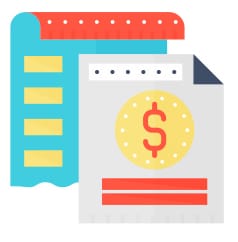
Investment example:
Investing money in better armor for a character, meeting other players while playing, creating a virtual community or building customised items.
Who talked about it:
Andrzej Marczewski
23. Status Points
Status points are used to rank people in levels. Each level can have different benefits and give users a different status. For example, 0000 points classify a user as siler “silver”, while 1001-3000 points classify them as “gold” members.

Status Points example:
Hotel loyalty programs and air miles frequent flyer points.
Who talked about it:
Yu-kai Chou
24. Boss Battles / Boss Fights
The Boss Battles or Boss Fights refer to a sequence of tasks and challenges where the player must battle and defeat a certain number of powerful enemies – or at least one, strong and powerful enemy. Use boss battles to test all the skills that users have acquired up to that point in the game.
Boss fights usually indicate the end of a journey or the beginning of a new chapter.

Boss Battles / Boss Fights example:
Fighting with bosses of every world in the Super Mario series and finally fighting Bowser at the end of the last world.
Who talked about it:
Andrzej Marczewski, Yu-kai Chou, Kevin Werbach and Dan Hunter
25. Avatar
An avatar is an icon or figure which represents a user in your application, product or service. Avatars can usually be chosen and at times can also be personalized. This gives people the feeling that they own and control the avatar, creating an emotional bond between the user and their digital persona.
Here are a few reasons why avatars may be a good mechanic to use:
- Fun: it’s fun to create yourself or someone else as a cartoon version or avatar
- Control: avatars promote a sense of control, and control is a biological need for survival. Without control, we feel threatened and insecure.
- Confidence: users can create alter-egos with avatars. If a person is an introvert, an alter-ego gives them the freedom to become an extroverted, funnier version of themselves. If a person is extroverted, they can create an alternate version of themselves. This plays with our ego.
- Engagement: avatars make an application feel more personal and friendly, promoting a feeling of ownership and possession.
Who talked about it:
Yu-kai Chou, An Coppens, Kevin Werbach and Dan Hunter
26. Narrative / Journey
What causes people to embrace a cause? What makes people progress in their careers or know absolutely everything about a specific product? All these questions rely on an important human motivator: purpose.
When you give purpose, you give people something that they want to dedicate their time and effort to. One excellent way to promote purpose with gamification is by implementing a powerful narrative. A narrative displays events that provide all the information people need so that they can take the appropriate actions. Narratives are about the chronological order of these events.
However, don’t mix the meaning of Narrative / Journey with the meaning of a story. Stories have beginning, middle, and end, being deeply connected to the behaviour and feelings of the main character. A story is an emotional bond that is created between the character and the final user. A narrative is a way to display events that will influence the user’s behaviours.
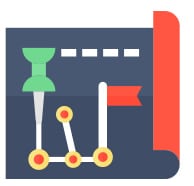
Who talked about it:
Andrzej Marczewski, Yu-kai Chou, Janaki Mythily Kumar and Mario Herger
27. Collect & Trade / Resource Acquisition / Transactions
Let users collect and trade items with their friends or with your system. Items can be cards, badges, coupons, points, or any virtual product available in the game. The trades or transactions can be done between users or with the system (shops, characters, etc) which can offer you better or improved items.
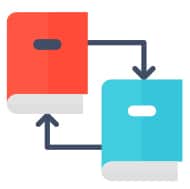
Collect & Trade / Transactions / Collection Sets example:
When you pick up a sword which you already have and exchange it with a friend for an Axe which you need.
Who talked about it:
Andrzej Marczewski, Yu-kai Chou, Kevin Werbach and Dan Hunter
28. Gifting / Sharing / Social Treasure
Social treasures are rewards that a user can only give or get from others. It’s even possible to create an entire “thank you economy” based on exchanging gifts amongst peers. After all, sharing is caring. For some people, there’s more pleasure in giving than receiving, so why not let users share items?
If you associate great rewards to this act, sharing can be a beautiful white hat mechanic which drives lots of fun and motivation.
However, if users become obsessed and make continuous requests to their friends, social treasure could become a black hat mechanic as well.
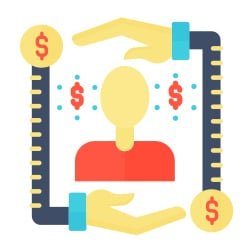
Gifting / Sharing / Social Treasure example:
Exchanging or giving:
- A Vote
- Information
- An extra-life
- Rare virtual objects
- Discounts and offers
- Badges
Who talked about it:
Andrzej Marczewsk, Yu-kai Chou, Kevin Werbach and Dan Hunter
29. Sharing Knowledge / Cooperation
There’s nothing greater than helping others. Allow users to share what they know by answering questions or teaching others. Teaching others is the best way to retain important information – especially when they get benefits in return, such as rewards, reputation, or even status.
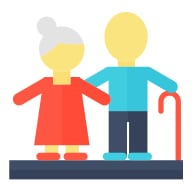
Sharing Knowledge / Cooperation example:
Reddit is a forum that works as a social news aggregator. There, users can gain karma points whenever their links and comments are upvoted – and lose karma points whenever their content is downvoted. After calculation, users get their own karma score, which is used to determine if someone is relevant on the website. If you have enough karma score you can even be allowed in a few private subreddit. Pure status and privilege gained through contributions!
Who talked about it:
Kevin Werbach, Dan Hunter and Andrzej Marczewski
30. Quests / Quest List
In gamification, quests are the set of rules and behaviours required from users to complete the game and win rewards. Quests can also be called missions and are composed of a set of challenges. A Quest List includes all the information on how to accomplish the challenges and how many points the user can get.
A gamification project can have just one quest or multiple different quests, designed according to their level of importance. For example, it’s possible to create an epic quest (the main goal), an achievement quest (regular assignments), standard quests and mini-quests
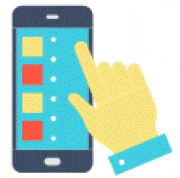
Quests / Quest List example:
You can increase business performance and engagement with a Quest List. How is this possible? Use your metrics and KPIs as quests. This way, users can complete daily tasks, monthly tasks and finally the epic quest, which in this case is their Annual Performance.
Who talked about it:
Andrzej Marczewski, Yu-kai Chou, Janaki Mythily Kumar, Mario Herger, Kevin Werbach and Dan Hunter
Download your free
“108 Gamification Elements and Mechanics”
Get your cheat sheet and have a quick reference at your fingertips!
31. Loss Aversion
Loss aversion is also known as loss and avoidance, referring to the motivation that comes from the fear of either losing something you have or an opportunity to win something.
No one likes to lose achievements, points, status, time invested or friends. So, to avoid the feeling of losing something people can create a distorted reality that hooks the brain into playing over and over again, no matter what. For that reason, game addiction can settle in.
Loss aversion is a powerful black hat motivator that reinforces risk-taking behaviour but it should be used carefully, since this plays an important role with reward uncertainty, as seen in the case of gambling

Loss Aversion example:
Anything that requires a sense of rapid response from the user or requires constant participation to avoid future losses. That can be triggering a competition, a temporary reward, promotion or coupon or daily bonus for playing, easily seen in games like Candy Crush that offers a reward to players that show up daily.
Who talked about it:
Andrzej Marczewski, Yu-Kai Chou, Janaki Mythily Kumar and Mario Herger
32. Voting / Voice
Allowing the majority of users to decide what they want is the best way to implement changes that everyone will be on board with. Giving users a voice is a way to respect their opinion and let them make decisions that are beneficial to the majority of people.

Voting / Voice example:
When members of a company are invited to vote in order to choose which improvements a company should make in a social space, such as the communal kitchen.
Who talked about it:
Andrzej Marczewski
33. Anonymity
Anonymity encourages freedom and a lack of inhibitions.
However, be careful because it has the potential to bring out the worst in people. Anonymity might be an interesting gamification tool but it’s always important to use it with great case.

Anonymity example
4Chan’s forums
Who talked about it:
Andrzej Marczewski
34. Gift Points
Gift points allow users to transfer points amongst themselves. Gift points can be associated with actions being completed, simple generosity or any other form of recognition amongst users. The same gift points can then be used for other purposes such as unlocking rewards, exchanging them for goods or coupons.

35. Expiring Points
Who hasn’t felt the pressure of exchanging their points for rewards before they expire? Expiring points are used to create urgency and accelerate customer acquisition or use of the points. Even when there’s a possibility to restore these points in the future, it’s always more advantageous to use them when they are still valid.
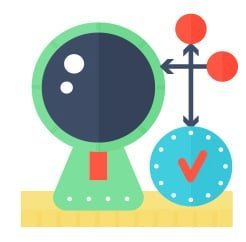
Expiring Points example:
Frequent flyer programs and credit card rewards are classic examples of expiring points.
Who talked about it:
Gabe Zichermann, Christopher Cunningham
36. Reputation / Karma Points
Reputation points have one rule: the more quality contributions or actions you take, the more reputation points you earn.
The difference with regular points is that when you perform negative actions your reputation will fall. If you don’t perform any actions, then your reputation will be neutral. However, in some cases performing no actions might be considered negative. Take a marketplace like eBay for example, if you stop responding to your customers, that’s a negative action which will consequently lower your reputation. The same applies for going beyond expectations which can be rewarded with additional reputation.

Reputation / Karma Points example:
Reputation points are often used for communities, like forums such as Reddit or in marketplaces where continuous positive interaction is required. Any scenario where continuous actions are involved is a great place for reputation points.
Who talked about it:
Gabe Zichermann and Christopher Cunningham
37. Signposting
Signposts are the helping hand that users need when they get lost and stuck in places. Giving clues is a big part of Signposting in order to ensure everyone gets into the game flow. There’s no time to lose! After all, no one needs to feel frustrated or demotivated, right?

Signposting example:
“Konnichiwa! Well done, you are almost there. There’s just 1 more step to complete your monthly mission. Maybe it’s time to schedule your performance meeting with your manager. Are you ready for that?”
Who talked about it:
Andrzej Marczewsk
38. Exchangeable Points / Virtual Currency / Virtual Economy
In gamification, it’s possible to create an entire virtual economy (or synthetic economy) based on redeemable or exchangeable points. Redeemable points are the virtual currency that allows users to exchange points for basically anything. Virtual economies can use both virtual goods as well as real world goods. Obviously the cost implications vary wildly between the two types of goods!
In gamification, users can earn redeemable points to purchase specific items, such as:
- Credits
- Discounts
- Coupons
- Physical rewards or gifts
- Collectables
- Boosters
- Status
- Upgrades
As your virtual economy grows, it’s recommendable to monitor and manage the flow of capital to match supply with demand, just like in real life.

Exchangeable Points / Virtual Currency / Virtual Economy example:
Earning points for each purchase made in an ecommerce store which can then be exchanged for discounts. Or an even more prevalent example, your standard air mile programs
Who talked about it:
Andrzej Marczewski, Yu-kai Chou, Gabe Zichermann and Christopher Cunningham
39. Choice & Consequences
Choices make the user think before taking an action. On the other hand, consequences make the users think about their actions as they are fed the results. Although games about choice and games about consequences are equally interesting, they require different approaches to game design due to their different outcomes.
How does that work?
Well, if the focus is on the choice itself, the engagement is found in giving users a number of options to consider. Choice motivates users by forcing them to see nuances which would have previously gone unnoticed. Conversely, if the game focuses mainly on consequences, the users have to think about the reactions their choices will cause. What exactly is the user going to lose or gain? Points, badges, social status?
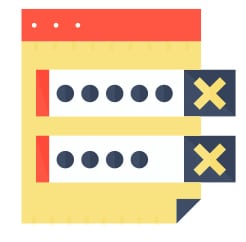
Choice & Consequence example:
A choice might be choosing a path for a character in a game. A consequence based decision might be deciding to leave your base for a long quest knowing that you risk losing your lodging.
Who talked about it:
Andrzej Marczewski
40. Countdown Timer
Countdown timers are visual displays that show users time counting down towards a particular event. The event can be a great opportunity or the expiration of a great opportunity. Countdown timers are a great way to make users recognise opportunities and take action before it’s too late.

Countdown Timer example:
A supermarket deal which gives you double points on your loyalty card if you shop online during the week before Christmas.
Who talked about it:
Yu-kai Chou, An Coppens, Janaki Mythily Kumar And Mario Herger
41. Theme
The game element Theme can be anything that makes sense to the aim of the project. It’s a way to connect the narrative, having a clear subject to engage users in a creative endeavor. A theme will permeate the whole story so that it has consistency.

Theme example:
Humor, adventure, medieval, fashion, sports, science fiction, etc.
Who talked about it:
Andrzej Marczewski
42. Customization
Customization does not interfere with the gameplay, but it does affect the user’s enjoyment of the game.
A great example is customising your character in the game. Choosing what they look like, what they wear, special items they can have or carry are just some ways a character can be customised. All of this can be done as part of the game or in exchange for digital currencies or even real money. This element can satisfy the users’ need for autonomy, increase their sense of control in the world, and motivate them to play the game again.

Customization example:
Avatars, character design, and environments are examples of customizations that can be done by the user.
Who talked about it:
Andrzej Marczewski and Yu-kai Chou
43. MiniQuests
MiniQuests are a great way to engage users by giving them small tasks to complete. These can be part of a bigger quest or they could be standalone nuggets Either way, it’s satisfying to complete these small tasks and see progress taking place.

MiniQuests example:
A mini-quest in the context of development could be adding a task to a task tracker and filling in it’s details.
Who talked about it:
Yu-kai Chou
44. Humanity Hero
Humanity hero is the game element that makes the world a better place every time the user performs a desired activity or behaviour. It’s when a user’s behaviour also benefits the well-being of others. With Humanity Hero, it’s possible to connect gestures of goodwill to build or strengthen:
- Sales relationships: incentivizing users to buy from you so others in need can also receive the same product or a percentage of the cost of the product.
- Marketing strategies: giving a charitable donation for every signup or friend recommendation.
- E-learning Incentives: offering something meaningful to those in need for every correct answer or level up.

Humanity Hero example:
Toms is an online shoe shop that associates every purchase on their website with supporting impact grants, shoe giving, sight restoration, and safe water systems.
Who talked about it:
Yu-kai Chou
45. Beginners Luck
Most of you will be familiar with the term beginners luck. It’s used in cases when a player who is new to a game, out plays and wins against more experienced players. Now, in a digital world this kind of luck can actually be controlled and explicitly given to players to make them feel more confident.
Beginners luck allows us to reward the users early and celebrate their accomplishments from the very beginning, encouraging them to dive further into the game. This is a great technique for onboarding users into programs, making them feel at ease and capable of progressing further.
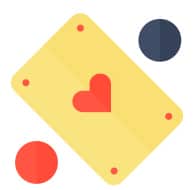
Beginners Luck example:
When you earn a reward for completing your very first training course or being recognised for completing your onboarding training
Who talked about it:
Yu-kai Chou and An Coppens
46. Evergreen Combos
Evergreen Combos are an essential element for the use of creativity that keeps users engaged with your system. Why is it that certain games have a certain level of engagement and when they are completed, the users stop playing them? Whereas other games seem to stand the test of time? The main reason is that the long lasting games make use of evergreen content. This is when the design of the game is such that the same content can be used in many creative ways to do things, leaving the decision of how that happens to the player’s creativity.

Evergreen Combos example:
Lego is a great example of evergreen combos. You have a predefined set of building blocks that can be combined in a variety of ways to create different things. Even chess is a good example, there are pieces and rules but the combination of how the pieces are used is up to the player. In a corporate world this could be the definition of an objective where the steps to reach it are loosely defined and the choice of how the objective is reached is left to the employee.
Who talked about it:
Yu-kai Chou
47. Certificates
A certificate is a physical symbol of mastery and achievement. It’s an official classification awarded for those who completed a significant feat or gained mastery in a particular skill.
Certificates are meaningful and carry status.
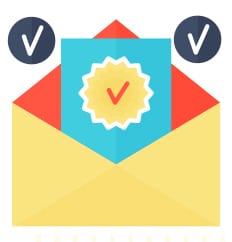
Certificates example:
Award of excellence, certificate of competition or completion.
Who talked about it:
Andrzej Marczewski
48. Free Lunch
A free lunch is when a user earns a reward without having to do anything, or hardly anything, to earn it. For example, your friend earns a prize which they can split amongst their friends and you happen to be one of the friends they choose, you just got a free lunch! If this is tied to a larger theme, it can make the users feel special and encourage them to take further action tied to your brand or business.
The psychological idea behind this game element is to make users feel connected and special so that they will perform desired behaviours in the future or even start to develop habits. Remember that emotion is what normally drives purchasing behaviour. Actually, emotions drive all sorts of decision-making behaviours. Believe it or not, 95% of our purchase decision happens in the subconscious mind, according to Harvard professor Gerald Zaltman.

Free Lunch example:
Fundraising or corporate events such as a cocktail night where you can bring along a plus one.
Who talked about it:
Yu-kai Chou, An Coppens, Janaki Mythily Kumar and Mario Herger
49. Unpredictability / Curiosity
Unpredictability and curiosity are responsible for keeping users interested, keeping them eager to learn more and dive deeper into the game.
Curiosity is considered one of the most important stimulants to educational accomplishments as it is linked to increasing not only interest but also memory retention. In order to spark curiosity, you can use the idea of unpredictability and surprise. After all, who doesn’t like the effects of dopamine being released in the brain?
However, keep in mind that curiosity is a critical factor that can influence people’s behaviour in both positive and negative ways. That’s why this core drive should be used carefully. Too many black hat mechanics can generate burnout and frustration, which can lead to a complete project failure. Better safe than sorry!
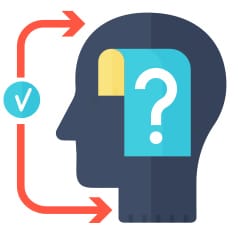
Unpredictability/Curiosity example:
Narrative or storytelling, randomness, rolling or sudden rewards, easter eggs, obvious wonder, evolved user interface, oracle effect, mini-quests, and glowing choice.
Who talked about it:
Andrzej Marczewski
50. Branching Choices
Branching choices or scenarios, make the users evaluate their options and actions and decide how they want to progress through the game. This gives the users the freedom to choose their path rather than having one chosen for them. Branching choices can result in different outcomes. Sometimes they can converge to the same place with different narratives and sometimes even lead to completely different endings.
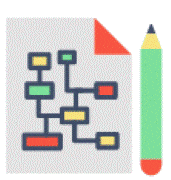
Branching Choices example:
Choose whether your character should reach their destination by crossing the mountains or going through the grass plains.
Who talked about it:
Andrzej Marczewski
51. Elitism
In gamification, elitism is the defense of a small and selected high-status group of users and its values against others. When creating elitism in a game, users foster group pride and can compete to maintain their status or superior qualities.
Rather than creating rivalry based battles that cause irrational activities and frustration, elitism can be used to create a group spirit. Once a group spirit has settled in, elitism can contribute to a bigger cause. So, instead of just playing against themselves for no significant reason, they can compete between themselves for donations, for example.

Elitism example:
In Kiva.org, first world countries can lend as little as $25 to help people around the world create opportunities for themselves and their communities. The platform created elitism formed by 2 groups: atheists and christians. Both compete against each other with visual statistics that show which group donates more and helps third world countries the most.
Who talked about it:
Yu-kai Chou
52. Easter Eggs
Easter eggs are sudden and unpredictable rewards. There are no clearly defined rules or behaviours that will trigger them. In fact, in many cases there are no indications that they even exist and they only become apparent once they are unlocked! This is different to random rewards where there is a well defined action with an unknown reward.
This type of reward adds an extra level satisfaction that will keep users coming back for more.

Easter Eggs example:
A game that provides you with a shovel for a specific purpose but which you can then use in an unrelated area to dig up some unexpected treasure.
Who talked about it:
Andrzej Marczewski and Yu-kai Chou
53. High Five
In gamification, a high five is a virtual message or notification of celebration given to users after finishing something meaningful. It’s pretty much the same as high fives in real life. High fives can also be used for peer-to-peer recognition as positive feedback and behaviour reinforcement.

High Five example:
When completing a tedious or difficult task, congratulate or notify the user that what they’ve just done is significant. This could be with an email applauding them or a popup notification congratulating them.
Who talked about it:
Yu-kai Chou and An Coppens
54. Water Cooler
Using a water cooler is a great way to stimulate social bonding and boost the morale of remote teams. The water cooler here refers to the communal area found in many companies where employees can take a break from their jobs and have some water or a coffee. They will usually cross paths with other employees and end up chatting about work or non-work related topics. This is a great way to foster social bonding and create a good company culture. It allows people to make connections, invest in trust-building and increases morale.

Water Cooler example:
Slack is a great example of how companies with remote workers or locations can bring people together.
Who talked about it:
Yu-kai Chou
55. Milestone Unlock
Milestone unlocks represent those rewards you receive for completing an important milestone in a game, like for example completing a level, killing a big boss or beating the lap record for a race track. Usually completing the milestone will reward you with a significant reward, for example when you complete a level you might get a reward which makes the next level easier, when you kill a big boss you might inherit the boss’ super power or weapon and when you beat the lap record you might unlock a faster car or powerful upgrade for your current one.

Milestone Unlock example:
Imagine a commission driven sales contact center where agents are divided into tiers. The higher the tier the larger the number of calls that are routed to you and the higher the quality of the leads. To move up in the tier scheme you need to close a certain number of deals, follow-up continuously, avoid missing work and perform better overall than the peers in your current tier. Unlocking the next tier is a milestone unlock.
Who talked about it:
Yu-kai Chou and An Coppens
56. Epic Meaning
Epic meaning calls on our need or urge to be a part of something bigger than us. When we are working towards a common goal of betterment, or doing something for the greater good. This can motivate people to an even irrational degree.

Epic Meaning example:
People contributing to Wikipedia are doing so free of charge and for the sole purpose of furthering humanities knowledge.
Who talked about it:
Yu-kai Chou, Jane McGonical, Janaki Mythily Kumar and Mario Herger
57. Instant Feedback
In the real world feedback tends to be slow and by the time you receive it, it might not even be relevant anymore. Take for example bi-annual work performance reviews or report cards in education. Now compare this to digital environments and games where the feedback is instant. For example, slay the big boss and you are rewarded, collect a valuable item and you are notified, or earn experience points and unlock the next level.
Giving people instant feedback will make them continuously aware that they are heading in the right direction, that they are taking the right steps towards their goals and objectives. They will also be incredibly relevant to the current situation the user is in, rather than outdated or obsolete like most performance reviews tend to be. It’s also a great way to align the employees actions with their manager’s or company’s expectations which in turn strengthens that relationship.

Instant Feedback example:
Completing a portion of a training course and earning points as well as seeing the progress bar get closer to completion. Or even completing the training course and seeing the progress bar reach 100% and being notified of the badge you earned, sealing your accomplishment.
Who talked about it:
Yu-kai Chou, Kevin Werbach & Dan Hunter
58. Lottery / Game of Chance
A lottery or game of chance is a game whose outcome is based on luck and not on skills or efforts required from the player. The only way to win in a game of chance is to participate. Other than that there isn’t very much to do. The random output is driven by different devices, for example things such as dice, software, roulette machines or mechanical devices like old school slot machines.
In gamification, a game of chance (or a lottery) is often seen in the shape of rolling rewards or sudden rewards. In both cases, the main goal is to make sure people keep playing the game. There’s no way they would opt out of a chance to win a great reward – and it can be really addictive! In addition, fear of missing out on an opportunity to win is a powerful motivational drive.
However, do keep in mind that this is a black hat technique, so use it with care and conscience.
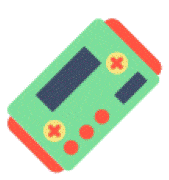
Lottery / Game of Chance example:
Roulette tables, dice games and slot machines
Who talked about it:
Andrzej Marczewski, Yu-kai Chou, Kevin Werbach & Dan Hunter
59. Booster
Boosters are something you can obtain that helps you reach a win-state with less effort. Usually boosters will work under specific conditions or for limited amounts of time. Imagine a racing game where you get a speed boost for 10 seconds which allows you to over take your opponents. Or the flower in Super Mario which allowed you to break blocks and spit fireballs.
Boosters can be used to temporarily empower and motivate employees to work towards their goals or customers to perform the desired actions. The secret is to create a booster that is meaningful to your customers, employees, learners or fans.

Booster example:
To engage teams, managers can offer half-day Fridays or a team lunch to boost their motivation. Customers can be given a limited time discount for each friend they invite to use your product.
Who talked about it:
Yu-kai Chou and An Coppens
60. Blank Fills
Fixed action rewards or the “earned lunch” technique is the easiest and most predictable type of the reward. Users know exactly what they need to do and what they will earn as a result of performing the specified action.

Blank Fills example:
Fill in the blank test is a very common type of evaluation or test used in education. It consists of a sentence with a blank space where learners provide the missing words or when there’s a question with multiple blanks to be filled with the correct answer.
Who talked about it:
Yu-kai Chou and An Coppens
61. Creativity Tools / Build From Scratch
Creativity tools, or the ability to build from scratch, gives users what they need to create their own content. This way users can personalize their own game experience and use their creativity to express themselves. What they build can be used to help others, for personal gain or just for fun.

Creativity Tools / Build From Scratch example:
Lego and SimCity, two games with infinite possibilities.
Who talked about it:
Andrzej Marczewski and Yu-kai Chou
Download your free
“108 Gamification Elements and Mechanics”
Get your cheat sheet and have a quick reference at your fingertips!
62. Alfred Effect
The Alfred Effect draws a parallel with Alfred, Bruce Wayne’s butler. For those who don’t know who Bruce Wayne is, this link should clear things up. The idea is that Alfred knows Bruce so well that he caters to his every need without even having to be asked. Alfred was a loyal companion, server, friend and guardian to Bruce.
So what does this mean in a digital context? The Alfred Effect is when a product or service is so personalized that the users couldn’t imagine themselves using anything else. It’s almost as if the product knew them, just as Alfred knows Bruce.

Alfred Effect example:
Google Search is based on your search history, Facebook shows you content based on your interactions, Netflix is able to predict what you will enjoy and Amazon makes surprisingly good recommendations. These are all examples of the Alfred Effect being driven by big data.
Who talked about it:
Yu-kai Chou
63. Aura Effect
The aura effect is when the actions of a player have a knock on effect on those who are close to them or in their vicinity. The aura effect can grant those users bonus points, more lives, skills or weapons in the game. In a business setting this could be represented by a team earning points, rewards or benefits thanks to having amongst them the top performing employee.

Aura Effect example:
When you recognise an employee as employee of the month but also recognise their team members as having contributed to that performance
Who talked about it:
Yu-kai Chou and An Coppens
64. Anticipation Parade
How do you show users they are on the right path and are just about to accomplish the win-state? Use the anticipation parade game element!
This game element can be a message or notification sent to the almost-winners to cause anticipation. It spices up the game right before the end of a mission, challenge or the game itself. It ties in nicely with progress bars and last mile elements.

Anticipation Parade example:
Messages like “you are almost there, only X to go!”
Who talked about it:
Yu-kai Chou
65. Group Quests
How to develop teamwork skills and increase collaboration and participation rates with gamification? Group Quests, also called Team Missions, is the perfect game element to get everyone interested in doing something that will benefit the whole team. Members can benefit from this group goal in many ways:
- Better communication skills: be open, share information, ideas, and suggestions in a respectful manner.
- Increased leadership: for assisting others in identifying, solving problems and achieving team goals. As well as notify others of delays, changes, or problems in a timely manner.
- Intrinsic motivation: knowing your role, your strengths, and how you can best contribute to everyone’s best.
- Better performance: getting the job done within the expected timeline.

Group Quests example:
When all sales agents work together to achieve their teams weekly target and all of them share the rewards.
Who talked about it:
Yu-kai Chou
66. Flow
Flow is extremely important to keep users in a zone of engagement, eventually allowing them to complete the game.
According to Mihaly Csikszentmihalyi, when skills and difficulty increase proportionally, users get into the ideal flow states. During his experiment, he discovered that someone’s skill is connected to the difficulty of a task, resulting in different emotional and cognitive states.
That means that when the task is too hard and the person’s skill is too low, the user becomes anxious. On the other hand, if the task is too easy and their skill is too high, the user gets bored.
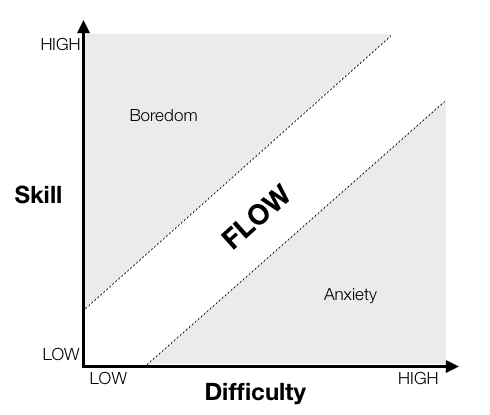
*Image: Model of Flow State
What are the user benefits from the flow state in a game?
- Users are focused on the task and extremely keen to complete the game
- Users experience a sense of mastery
- Users combine action and awareness
- Users experience loss of self-awareness and distortion of time
- Users are highly productive, as they truly enjoy the task
What are the characteristics needed in a game to achieve the middle term between skill and difficulty?
- Have tangible goals with manageable rules
- Identify the user’s skills and apply actions according to their capabilities
- Clear and timely feedback on performance and goal accomplishment
- Reduce distractions, thus facilitating concentration
- Allow users to develop exceptional organization skills – helping users to stay on top of their tasks and complete their duties in a timely manner

Who talked about it:
Andrzej Marczewski
67. Tout Flags
Tout flags are a way of showing people your accomplishments without directly telling them about them. In a game this could be through a special badge on your profile that can only be earned by completing a really tough challenge or through some piece of equipment which cannot be easily earned. In real life this could be the diplomas hanging in your doctors office and in a digital scenario it could be the recognition given to you by the president that you show in your LinkedIn profile.
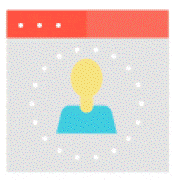
Tout Flags example:
When people leave their titles, skills or achievements exposed in their social media profiles
Who talked about it:
Yu-kai Chou
68. Brag Button
Bragging is defined as speaking proudly about your accomplishments, achievements or possessions. Adding a brag button allows users to broadcast their accomplishments to their friends and peers. This is a great tool to encourage new players to join and in the process advertise your product, service or incentives program. Note that although both this element and the Tout Flags are similar in nature, how the broadcasting of one’s achievements takes place is considerably different.

Brag Button example:
Duolingo’s fluency badges which can be shared on LinkedIn
Who talked about it:
Yu-kai Chou
69. Time Pressure
Have you ever felt stressed over a countdown? Well, we probably all have. Time is precious and limited – especially when you don’t have enough to get what you most desire.
Using time pressure deeply influences users’ decisions and the direction of the gameplay. Users become more focused on the solution and achieve their goals faster than they would have without time pressure.

Time Pressure example:
Insert a limited time for something to be performed or rewards to be earned. It can be a 24-hour window to solve a task, answer a question or solve a puzzle.
Who talked about it:
Andrzej Marczewski and Yu-kai Chou
70. Progress Loss
In games, Progress Loss is a feedback mechanic used to motivate players to keep playing. If they stop, they will progressively lose their hard earned points, status, achievements, and so on. In order to use this mechanic effectively, you need to be able to balance the level of progress less with the will of the user to continue playing. So if you remove too much progress, the user may feel there is no point in continuing. However, if the progress loss happened only until a predetermined amount or maybe could be paused after a period of time, then you would still keep the motivation without pushing the users away for good.

Progress Loss example:
In SimCity, the Contest of Mayors is a good example of progress loss. When playing a Contest of Mayors, there are 6 possible leagues to achieve:
- Megalopolis League
- Metropolis League
- City League
- Town League
- Suburban League
- Neighborhood League
100 players start at the bottom in the neighborhood league, and they have 5 days to complete the maximum number of assignments possible to climb the leaderboard. If they are among the 20% of best players, they will proceed to the next league. However, if they don’t perform well or stop playing and they drop below the 20% best performers mark, they go down a league. This prompts users to continue playing.
Who talked about it:
Yu-kai Chou and An Coppens
71. Prize Pacing
Prize pacing is when a reward is broken down into smaller pieces which can be won on a regular basis. In order to collect the full reward, the users need to collect all the smaller pieces. Obviously there is a tipping point, once you have enough of the smaller pieces the full reward becomes much more interesting. Think of your sticker album, at the start it’s fun, but when you have only a few missing stickers it suddenly becomes critical to find the missing pieces.

Prize Pacing example:
A good video game based example are the hearts in the Legend of Zelda game series. In order to get a new heart (i.e. more life) you need to first collect all the heart fragments. Once you have 4 fragments, you get the full heart.
Who talked about it:
Yu-kai Chou and Ann Coppens
72. Mentorship
Getting started in a new environment can be a daunting endeavour. A great way to make this experience more enjoyable is to pair your new recruits with someone who has experience and who can teach them how things work. This is a mentorship or buddy program in action.
Not only are mentorship programs great for the new recruits (increasing their job satisfaction and longevity) but it’s also great for the mentors who get to show the recruits how things are done.

Mentorship example:
Many companies have a mentorship or buddy program where a new recruit is paired with a more experienced veteran who shows them the ropes.
Who talked about it:
Yu-kai Chou
73. Social Prod or Nudge
A Social Prod is a simple action which causes a social interaction of some sort. Imagine the poke button on Facebook. This action didn’t really carry any significant meaning, all it did was nudge the person on the other end. It was really an excuse to notify them that they had been poked and cause them to take action (generally by poking back). Sending a simple message using just an emoji works in very much the same way. The emoji may not carry a great deal of meaning, but on the receiving end it’s likely to cause a reaction and a response.

Social Prod or Nudge example:
Facebook had the poke button and LinkedIn has the endorsements.
Who talked about it:
Yu-kai Chou
74. Desert Oasis
The desert oasis is a clean visual design that highlights only the expected goal or behaviour, like an oasis in the desert. This can be an extremely handy technique when you want users to focus on a particular action as there should be little to no distractions involved. Subconsciously you’re also indicating to the user that there is a win-state associated with this action.

Desert Oasis example:
The “Add to Basket” or “Proceed to checkout” buttons in Amazon website.
Who talked about it:
Yu-kai Chou
75. Magnetic Caps
Magnetic caps limit the number of times a user can perform a specific action. This in turn motivates the users to perform more of those limited actions. Studies show that when we make an item abundantly available, people will take a balanced approach and take the number of items they feel is sufficient. However, if we set an upper limit to how many items one person can have, people tend to edge towards that upper limit, even if in the case of abundance, they may have taken half as many items.
For example, if we have a website with tutorials and offer as many free tutorials as possible and people on average consume 3 tutorials, we can increase the rate of consumption by limiting access to 5 tutorials per person.
Obviously this begs the question, what about those users who were going through more tutorials? Well, the key here is to allow the users to earn the right to a higher cap. This way they can work towards gaining access to more tutorials.

Magnetic Caps example:
An elearning site which offers unlimited access to tutorials and then caps it at 5 tutorials per person.
Who talked about it:
Yu-kai Chou
76. Last Mile Drive
The last mile drive is all about letting the users know that they are close to the end goal and helping to boost their motivation in order to cross the finish line. The incentive can come in the form of a reminder, and email or even a progress bar which gives the users visual queues in relation to their progress.

Last Mile Drive example:
Any kind of reminder: progress bars, timers, notifications, emails
Who talked about it:
Yu-kai Chou
77. Torture Breaks
If you’ve played mobile games before, then you’re probably familiar with the concept of torture breaks. Torture breaks are a sudden and often planned pause during your gameplay. For example, when you run out of lives and you need to wait 1 hour before you can play again or when you start to build something and it’ll take another 5 hours to be ready.
This may be counterintuitive, as you might think that the idea is to get people to play as much as possible. However, forcing breaks will actually trigger the impatience core driver which actually ends up creating an obsessive behaviour whereby users end up checking the game every few hours even though they know that the time hasn’t elapsed yet!

Torture Breaks example:
Most people will have heard of Candy Crush, it’s one of the most popular mobile games of all times. In the game you will run out of lives trying to pass levels and when you do, you will need to wait 30 minutes before you get a life back. This is a classic example of a torture break. Obviously they give you shortcuts to skip the torture break. These are (1) inviting your friends to Candy Crush or (2) paying to skip the break.
Who talked about it:
Yu-kai Chou
78. Virality
Virality is the concept of using game mechanics and engagement loops to bring more players to the game. For example, rewarding users who get their friends to participate, requiring teams to be formed to progress in a game, or even Candy Crush’s get a life from a friend concept.

Virality example:
Dropbox offers lots of extra space everytime you invite a friend (up to an upper limit, but still quite a bit of extra space).
Who talked about it:
Janaki Mythily Kumar and Mario Herger
79. Crowning
How do you recognize a person who is giving their best at work? How to reward and support excellent participation and performance? Crown them!
Let users know which performance is supreme and create a special status or even a badge for whoever accomplishes that. Make it visible so everyone else can aim for it too. Crowning is the perfect game element to promote a sense of accomplishment.
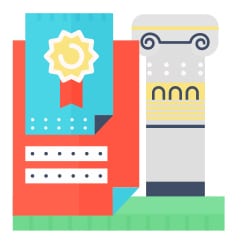
Crowning example
Identifying your top performer of the month and recognising them through a ceremony where they are crowned as employee of the month. Then put their foto up on the wall where everyone can see who they are.
Who talked about it:
Yu-kai Chou and An Coppens
80. Recruiter Burden
The Recruiter Burden usually happens when you’re trying something new and you recruit people to join you. This causes you (the recruiter) to want to demonstrate to your recruits that the new product or service is really worth their while.

Recruiter Burden example:
Being a content creator and convincing people to follow you on Youtube, Twitter, Instagram, Facebook or Snapchat and then feeling like you need to deliver fresh content to prove to your recruits that they made the right choice. An alternative would be a collaboration tool where you invite (recruit) users and then start to share with them to demonstrate how effective the tool is.
Who talked about it:
Yu-kai Chou
Download your free
“108 Gamification Elements and Mechanics”
Get your cheat sheet and have a quick reference at your fingertips!
81. Conformity Anchors
Conformity Anchors, also known as Social Norm Interventions, happen when we have the majority of friends’ attitudes and behaviours influencing our own, such that we decide to normalise (i.e. behave in the same way). It’s a situation in which you decide to follow what the majority are doing even when we don’t necessarily agree with them.
So why are we so relaxed and accepting of a situation, rather than trying to alter or control it? People are frequently motivated to conform to others’ beliefs and accept their behaviours in order to enhance, protect, or repair their own self-esteem. So, they just go with the flow because it’s easier.

Conformity Anchors example:
If you move into a neighborhood where all the lawns are trimmed, the likelihood is that you will also keep your lawn trimmed.
Who talked about it:
Yu-kai Chou
82. Glowing Choice
The glowing choice is used to guide users in the right direction. This mechanic is often involved in the onboarding stages of a game. It effectively highlights the next step you should be taking in the midst of a difficult or complex scenario. This can be easily translated into an application by highlighting a button or what action the user should be taking next. The glowing choice mechanic appeals to our curiosity and will generally attract our attention. This kind of guidance helps us create a positive experience for a user. If left to their own devices, it’s easy for a user to slip into a bad experience
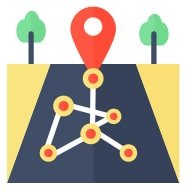
Glowing Choice example:
When you first log into Slack it takes you through an onboarding process which includes highlighted areas and contextual tool tips.
Who talked about it:
Yu-kai Chou and An Coppens
83. Appointment Dynamics
Appointment Dynamics are a great way to use a declared or recurring schedule during which users need to take action in order to gain a benefit. Black Friday is a great example of an appointment dynamic that happens every year and has people queuing up outside shops to reap the benefits of it. Another great example are restaurant lunch time promotions from Monday to Thursday to guarantee a flow of customers on days that are usually quieter.
Appointment dynamics act as a trigger to cause users to take action on a predetermined schedule. This is a great way to bring users back to your product on a regular basis. You can trigger emails or notifications from an appointment dynamic which then reminds the user to take action.
Appointment Dynamics is a very common technique and can be used to drive feelings of scarcity and impatience. Obviously this is a black hat mechanic which means it should be used with care.

Appointment Dynamics example:
The Fork is a popular app owned by TripAdvisor. This app connects clients and restaurants and exists to:
- Help people save money when booking tables in restaurants.
- Bring in more clients.
- Provide feedback in the form of reviews and stars, which helps restaurants to fix quality issues.
An example of how the application uses Appointment Dynamics is the 50% discount give by some restaurants during the Oktoberfest period.
Who talked about it:
Yu-kai Chou and An Coppens
84. Visual Storytelling
Storytelling is a very powerful technique when it comes to motivating people. Here are just a few reasons why it can be so useful:
- Storytelling helps you emotionally connect users with your product.
- It makes people feel involved when unlocking a new achievement or level.
- It holds people’s attention while at the same time explaining what’s going on based on their progress – after all, their path to mastery should be easy and interesting!
- Gives a sense of curiosity and excitement for what’s going to come next.

Visual Storytelling example:
A good example of visual storytelling can be seen in Minecraft
Who talked about it:
Yu-kai Chou
85. Protector Quest
A protector quest is used to build user affection and emotional attachment with something they are in charge of protecting. It can be a baby, it can be a farm with animals, it can be a file on your harddrive, basically it can be anything your scenario determines.
Why does this bonding happen? Well, your brain needs to find a way to justify your actions so they have meaning. So you end up creating an emotional attachment to whatever you need to take care of.
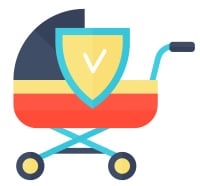
Protector Quest example:
A simple example for those of us from the 90s is the Tamagotchi. People used to get really upset when their Tamagotchi died.
Who talked about it:
Yu-kai Chou
86. Exploration
Give your users the freedom of movement. The ability to explore uncharted territories and discover the unexpected. It’s allowing people to wander and discover the unknown. Exploration is usually linked to virtual worlds, like new planets or cities. For some game designers, exploration isn’t an activity in itself but a theme that is evoked by supporting mechanics.

Exploration example:
Any game which has a large virtual world which can be explored at your own pace such as Assassins Creed or Far Cry.
Who talked about it:
Andrzej Marczewski
87. Urgent Optimism
Urgent optimism is based on the feeling we get when we’re nearing the end of a task and we get that sudden urge to go for a final push to get it over the line. Once the task is done there is a sense of accomplishment which is rewarding in itself, but many times there are also real rewards, like going on holiday after handing in that last report to your boss.

Urgent Optimism example:
When you find yourself involved in a deliverable at work and you see that light at the end of the tunnel, so you hunker up and just get it done.
Who talked about it:
Janaki Mythily Kumar and Mario Herger
88. Evolved UI
Many applications provide their users with a plethora of options and features right away. This can be fairly overwhelming and cause users to freeze up due to Decision Paralysis. Too many options will give your application a feeling of complexity, which isn’t necessarily a bad thing, as long as you guide users towards it.
In most complex games what you will find is that they will expose users to the complexity in a paced fashion. They will start with only a few options and as the user evolves and gains confidence in those features, they start to unlock new options.
This gradual evolution of the interface is known as Evolved UI. Where we gradually expose the users to complexity rather than overwhelm this with a big bang approach
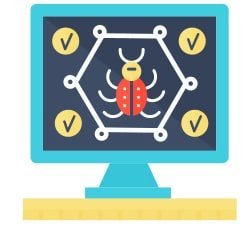
Evolved UI
Onboarding in most games of a certain complexity adopts this approach.
Who talked about it:
Yu-kai Chou
89. Oracle Effect
The oracle effect is where a prediction about the future keeps the user engaged until they can determine if the prediction is true or not. This effect can be produced by indicators of things that are about to happen or indicators that create the basis for an educated guess. When the national lottery has no winners and the prize is big, chances are a win is about to come and people will stay tuned until they find out if somebody has won.

Oracle Effect
When Waze tells you that there is a broken down car on the hard shoulder or that there is a speed camera up ahead, they keep you tuned until you see the car or camera.
Who talked about it:
Yu-kai Chou and An Coppens
90. Evanescent Opportunities
Evanescent opportunities are those situations where your users must take the desired action immediately or lose the opportunity that was presented to them. Evanescent opportunities encourage us to take action for fear of losing a great deal. Have you ever purchased something online and been sent a discount code for X percent off but you need to use it within Y days? That is a perfect example of an evanescent opportunity.

Evanescent Opportunities example:
In Plants vs. Zombies, yetis are the best example of Evanescent Opportunity: they are rare, and if you don’t kill them right away, they start to walk backward until they disappear.
Who talked about it:
Yu-kai Chou
91. Dangling
The idea behind dangling is to tease the user with what they could achieve, until they take the desired actions to achieve it. Initially the user may not be interested, but through continued exposure and as they commit to your product or service, the carrot can become much more interesting. Now, the reward they are going to receive should be fairly hard to achieve, but not impossible, otherwise people will dismiss it.

Dangling example:
Most pay to play games use some form of dangling to entice you into purchasing virtual goods or benefits. As users get more involved in the game, they start to pay attention to the deals and offerings which you dangle in front of them. Many times these can be achieved through game play but the amount of time it would take to earn them would be fairly large. That generally tends to convince users to spend a couple of bucks on the item rather than spend 50 hours trying to unlock it
Who talked about it:
Yu-kai Chou
92. Rightful Heritage
Rightful heritage is a mechanic easily shown through examples, yet hard to explain. Effectively it’s when a system makes you feel like you’ve earned something (it is rightfully yours) but you will lose it if you don’t perform the desired behaviour.
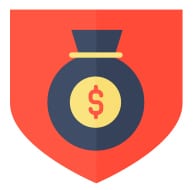
Rightful Heritage example:
Imagine an ecommerce store where you could progressively earn discounts by browsing through their goods or reading the reviews or rating clothes. Each meaningful group of actions you take being rewarded. You would feel like you are entitled to those discounts because after all you’ve earned them. Chances are you will also be more likely to want to redeem them instead of lose them or let them expire.
Who talked about it:
Yu-kai Chou
93. Status Quo Sloth
The status quo sloth is based on the premise that it’s difficult to break a habit. People don’t like change and once they’ve built a habit, they prefer to keep it rather than to give it up. The idea is that we want to design an experience with engagement loops that turn our users’ actions into a habit, hence forming a status quo sloth. This will keep the user engaged for long periods of time even once they have mastered the game. If you want to build an engagement loop take a look at Nir Eyal’s work for a great framework.
Status Quo Sloth example:
Facebook forms habits using notifications and emails to bring you back into the platform. Once you are in you will take different actions, for example, posting, liking pictures or maybe even uploading your own. All these small investments hook you into the product. Periodically new notifications bring you back into the system and as this process repeats itself, you begin to form a habit.
Who talked about it:
Yu-kai Chou
94. FOMO Punch
It’s fairly challenging to get people to break habits. The FOMO punch comes in to help us counter this. FOMO stands for “Fear of Missing Out”. The concept is based on the fact that we don’t just fear losing what we have, we also fear losing what we could have had. Many times that’s a sufficient stimulus to get us to take action.

FOMO Punch example:
When a game gives you a preview of what could happen if you would choose a specific path.
Who talked about it:
Yu-kai Chou
95. Win States
The win states are the victory moments in the game. It usually indicates that you have overcome some kind of a challenge.

Win States example:
Completing the first world in Super Mario World or even simply completing the first level of the first world.
Who talked about it:
Yu-kai Chou
96. Monitor Attachment
When you see people constantly monitoring progress and paying attention to check how something is going, it’s because they’re experiencing Monitor Attachment. This game element makes people develop ownership towards something, and by consequence they feel the need to constantly check on it.

Monitor Attachment example:
Posting a picture on Instagram and constantly going back to see how many people liked / commented on it or picking a stock and then constantly looking at it’s fluctuations.
Who talked about it:
Yu-kai Chou
97. Big Burn
Big burn represents those items in a game which are extremely expensive or difficult to obtain. Whether this is because it takes an extremely long time to get or because you need a ridiculous amount of points to purchase it.

Big Burn example:
Many games have extremely hard achievements to unlock, here are a few examples.
Who talked about it:
Yu-kai Chou
98. Social Engagement Loops
Social engagement loops are those situations where a call to action re-engages a user eliciting a motivating emotion which in turn makes the user more likely to respond to the next call to action. This can be seen perfectly in Amy Jo Kim’s workshop slide 140.
To summarise the loop:
- (social) Call to Action: Customize / Share / Help / Compete / Follow
- Player Re-engagement: Task / Mission / Game / Quiz
- Visible Progress or Reward: Pts / Stats / Awards / Messages
- Motivating Emotion: Fun / Delight / Trust / Pride / Curious
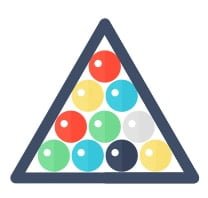
Who talked about it:
Amy Jo Kim
99. Plant Pickers
Plant Pickers, also known as meaningful choices, is present in games that allow users to pick their personal strategies, tools or styles in order to reach the win-state. The idea is that there is no single way to reach the win-state but rather that each user has the freedom to pick the way they want to reach the win-state based on personal preference (like picking flowers for your garden). This game element empowers users to use their creativity and autonomy, which are an essential ingredients when it comes to creating an evergreen system.

100. Turns
Turn is a game mechanic that allows players to have sequential participation by alternating between them. This would involve each player taking their turn before the next player can play. It’s the opposite of the simultaneous mechanic, where players can choose their actions without knowledge of the actions chosen by other players.

Turn example:
Most board games have the turn mechanic, for example Monopoly or Risk
Who talked about it:
Kevin Werbach and Dan Hunter
101. Blissful Productivity
Blissful productivity is driven by the feeling we get when we’re crossing items off our todo list. Think about people playing video games for hours on end, accomplishing harder and harder feats. It’s the same exact feeling, it’s a continuous state of productivity. You will find that people are willing to work hard to achieve that state of blissful productivity.

Blissful Productivity example:
Jane McGonical discusses in her TED talk how World of Warcraft players spend hours after their day jobs playing in a state of blissful productivity.
Who talked about it:
Jane McGonical, Janaki Mythily Kumar and Mario Herger
102. Sunk Cost Prison/Tragedy
The sunk cost prison happens when users invest so much time and effort in something that they are afraid to walk away from it and lose everything they have achieved. The sunk cost prison is powerful enough that even when we no longer enjoy what we’re doing, we still fear walking away from it.
This happens often with games where users have invested countless hours in unlocking achievements, earning virtual goods, accumulating points, and so on. However, this can also happen with regular applications. For example, think about the countless hours you’ve invested in Facebook, maybe it’s uploading photos or thoughts, or maybe you used to play Facebook games, or maybe it’s the only means you have to keep in touch with certain people. Whichever reason, it’s always hard to decide to deactivate your Facebook profile.
The sunk cost prison technique taps into our feelings of loss avoidance which is considered a powerful black hat mechanic. It’s important to balance this with white hat mechanics so that we don’t leave our users feeling like our system is making them constantly uncomfortable.

Sunk Cost Prison example:
The time spent on Facebook collecting photos and friends makes it hard to walk away and deactivate your account.
Who talked about it:
Yu-kai Chou
103. Community Collaboration
Community collaboration is used to create a sense that working together is better than working alone. Since working as a community or a group enables us to overcome difficult obstacles and win.
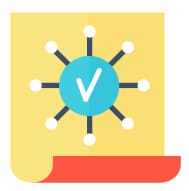
Community Collaboration example:
When you need different characters with different abilities to complete a task in a game or when you need a multi disciplinary team to complete a project.
Who talked about it:
Janaki Mythily Kumar & Mario Herger
104. Poison Pickers/Choice Perception
Studies show that people are happier when given a choice, even if the choice they are presented with is meaningless. This could mean that the options they are presented with are equally unappealing or only mildly different, but the simple fact that they get to choose, makes them feel better about it. This is what is known as Choice Perception or Poison Picker.
Wondering why the simple fact of having choices makes humans feel powerful? According to the Ph.D Susan Weinschenk, we think that choice is control, and control means survival: We need to feel in control.

Poison Pickers example:
When you have multiple options to choose from but none of them are good, like picking a customer complaint ticket to deal with.
Who talked about it:
Yu-kai Chou
105. Scarlet Letter
The Scarlet Letter is a game mechanic that uses a common type of fear: social disapproval. For some, their own performance is only a concern when other people can see it.
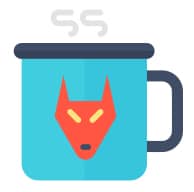
Scarlet Letter example:
a task management software where task duration is tracked and publicly shown. Each time the progress is reviewed everyone will see how long people have been on a task. This forms an internal pressure to complete the task because you know others are watching and maybe taking less time than you.
Who talked about it:
Yu-kai Chou
106. Visual Grave
The concept of the visual grave mechanic is to show users inspiring graphics when they fail, motivating them to get back on the horse and try again. You want to encourage people to take their next attempt.

Visual Grave example:
When someone doesn’t reach their targets and the team leader mentions their fail but encourages the next step, saying things like “we’ll reach it next month for sure”
Who talked about it:
Yu-kai Chou
107. Moats
Everybody knows what a moat in real life is, right? Castles all over the world have this deep, broad ditch dug around them for protection. In gamification, it represents a big challenge the user needs to overcome with a serious skill-based assessment to either pass or fail. In games these could represent big boss fights or serious challenges which test the players ability and skill.

Moats example:
Any big boss fight which needs to be overcome to reach the next level represents a moat. In a business world this could be applied to a learning scenario where users need to complete quizzes on previous courses before moving onto the next ones.
Who talked about it:
Yu-kai Chou and An Coppens
108. Collection Sets
Collection sets are related items which belong to a theme that you can collect throughout the game. The items can be collected in any way you like, but the idea is that they belong to a closed set of items which you desire to collect. As you increase the number of items in your collection set, the drive to finish the set kicks in (Urgent Optimism).

Collection Sets example:
Sticker books are examples of collection sets (even though the stickers are not collected in the game but rather purchased at regular intervals).
Who talked about it:
Yu-kai Chou
Conclusion
What is tricky about gamification elements and mechanics is that they don’t work as a stand-alone solution.
The collection of gamification elements we provided here is definitely a good start, but it’s also important to understand how to piece it all together in order to understand where motivation comes from and how you can obtain the desired results.
Let’s have a scoping discussion about your gamification needs and how we can help you meet them.



